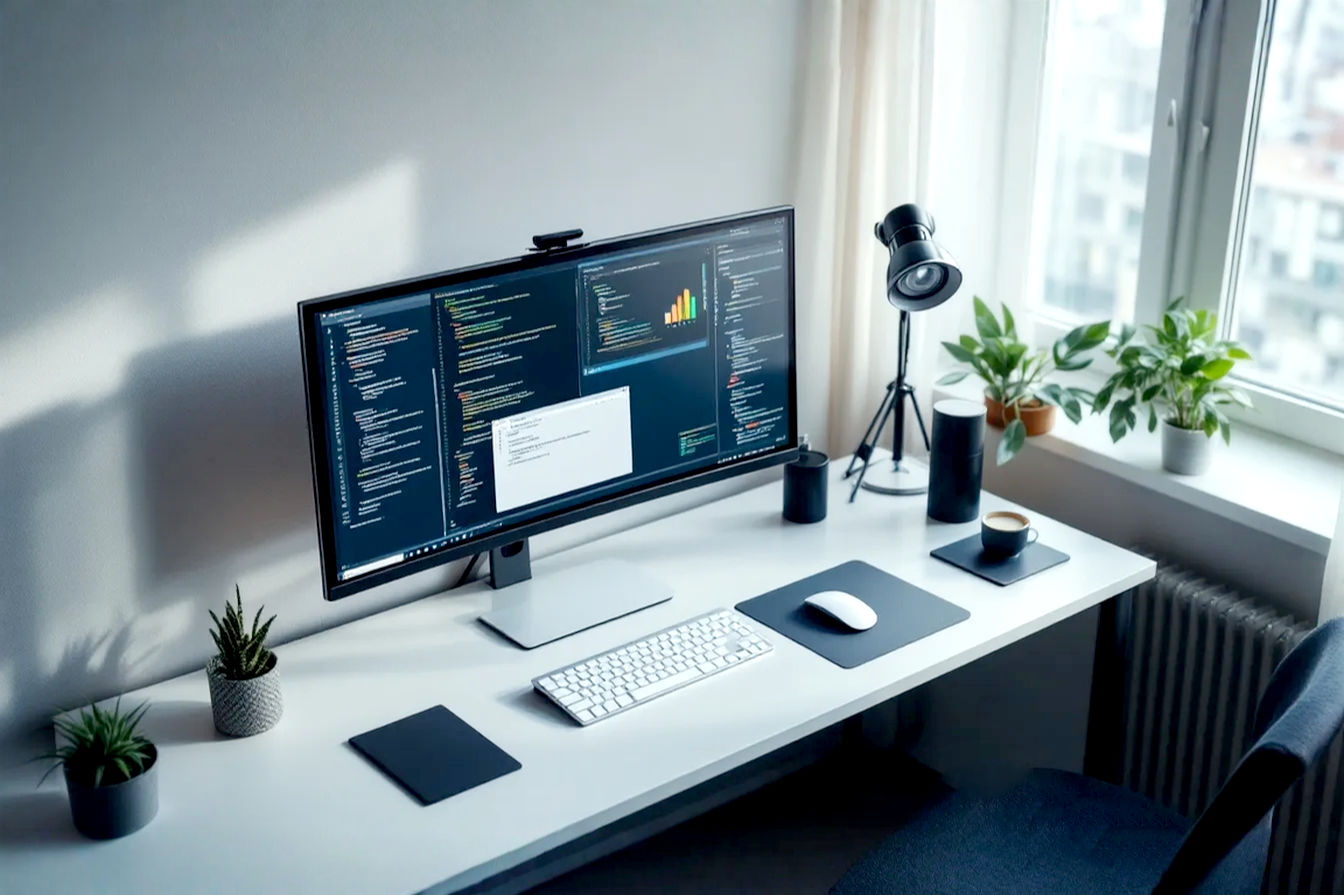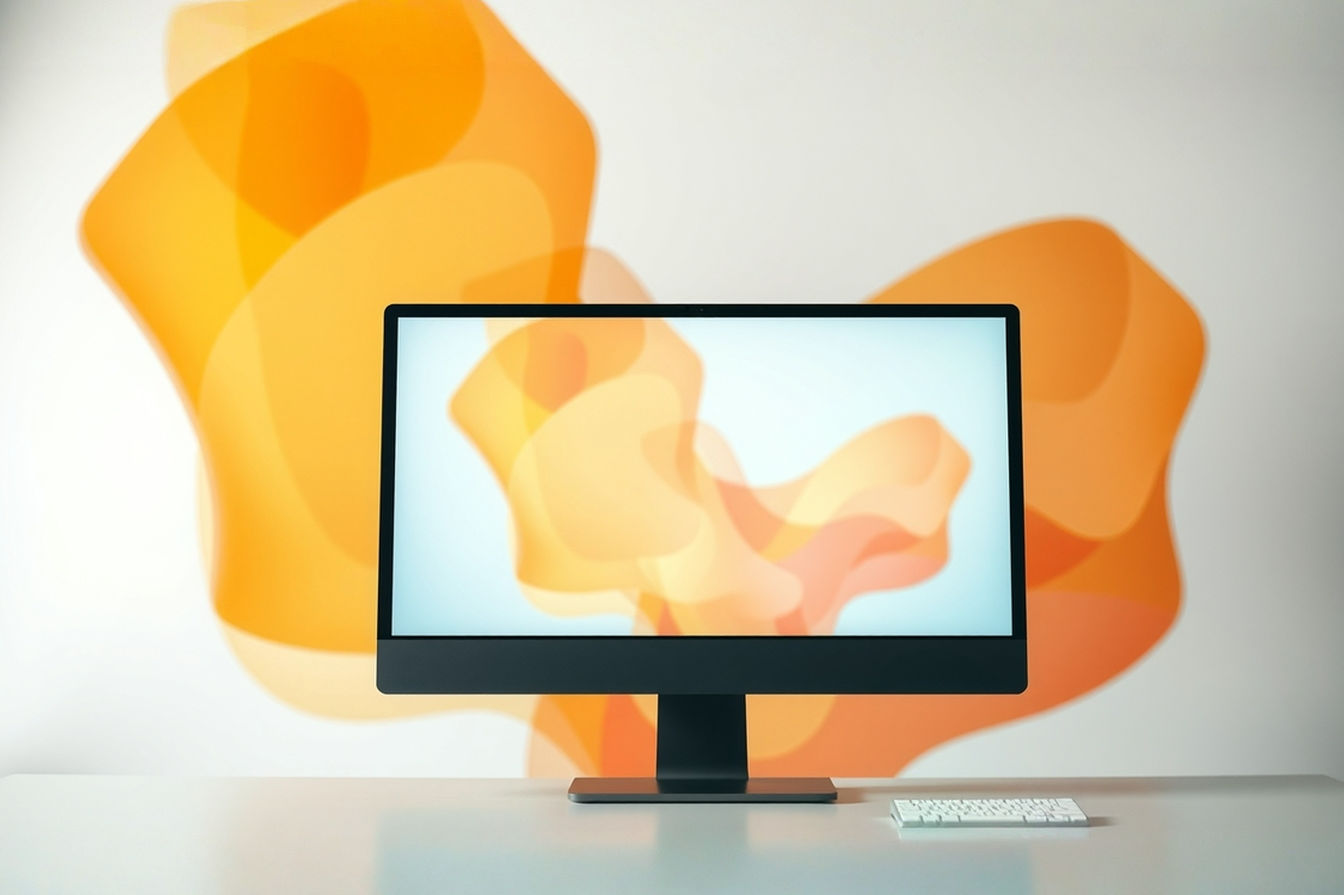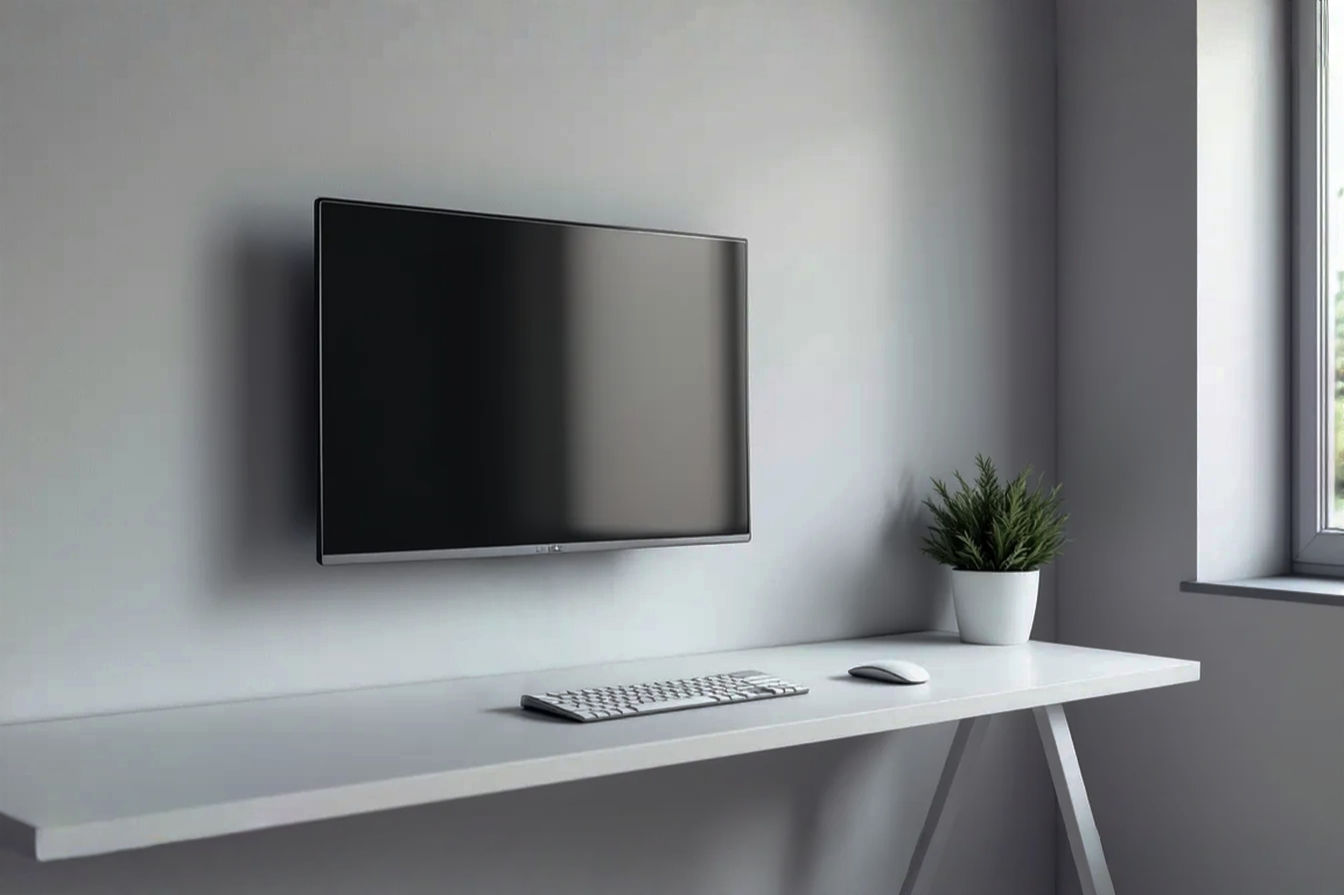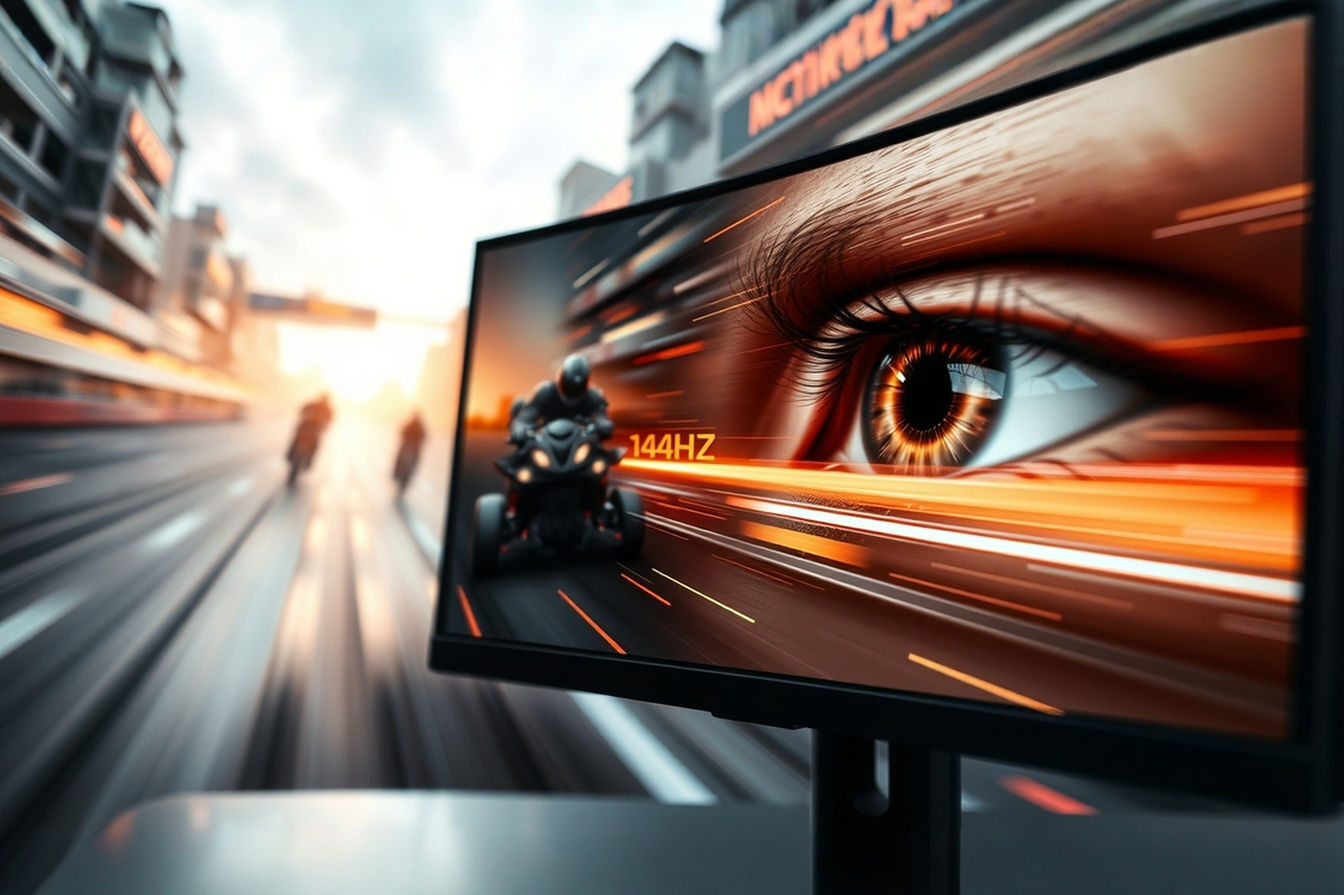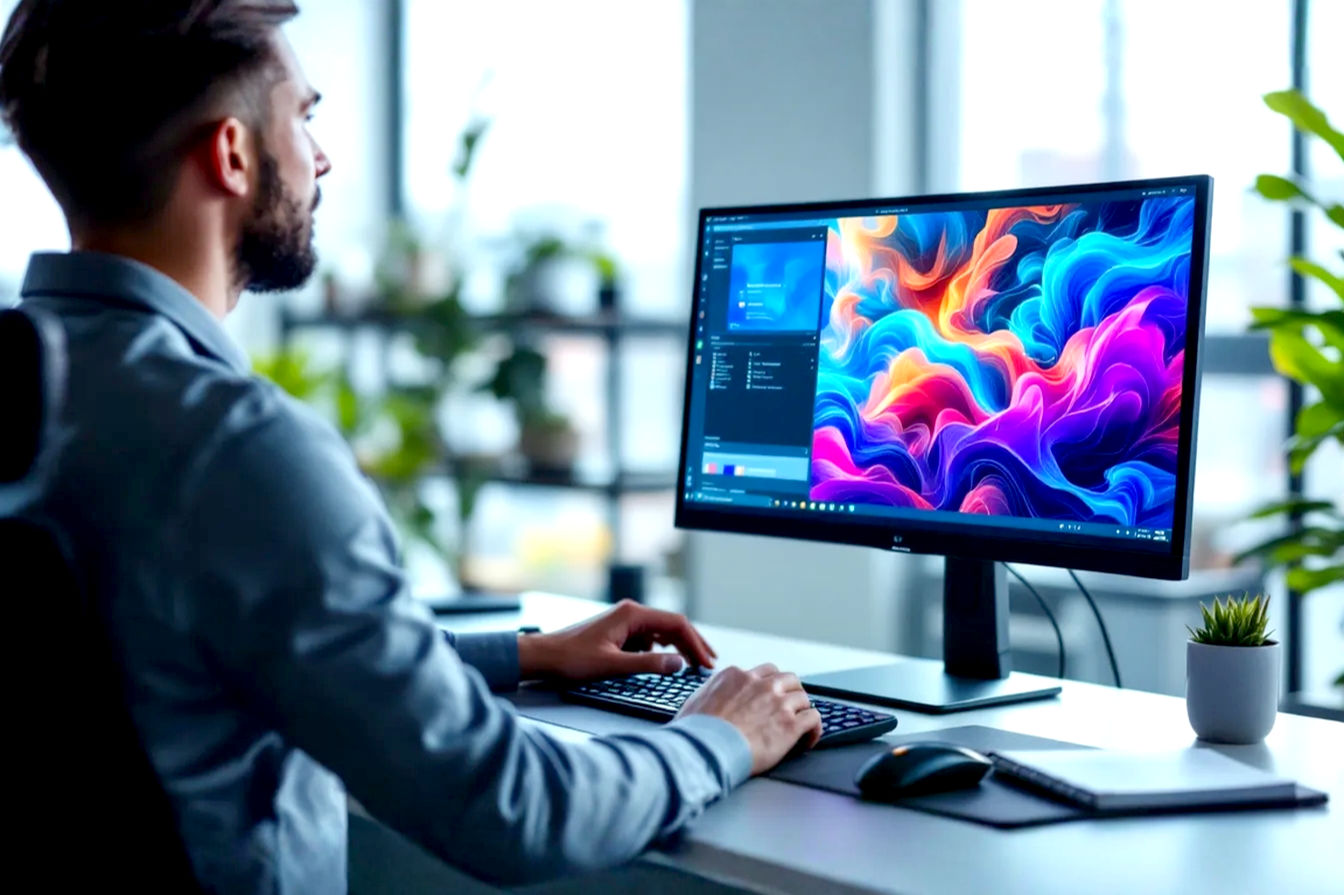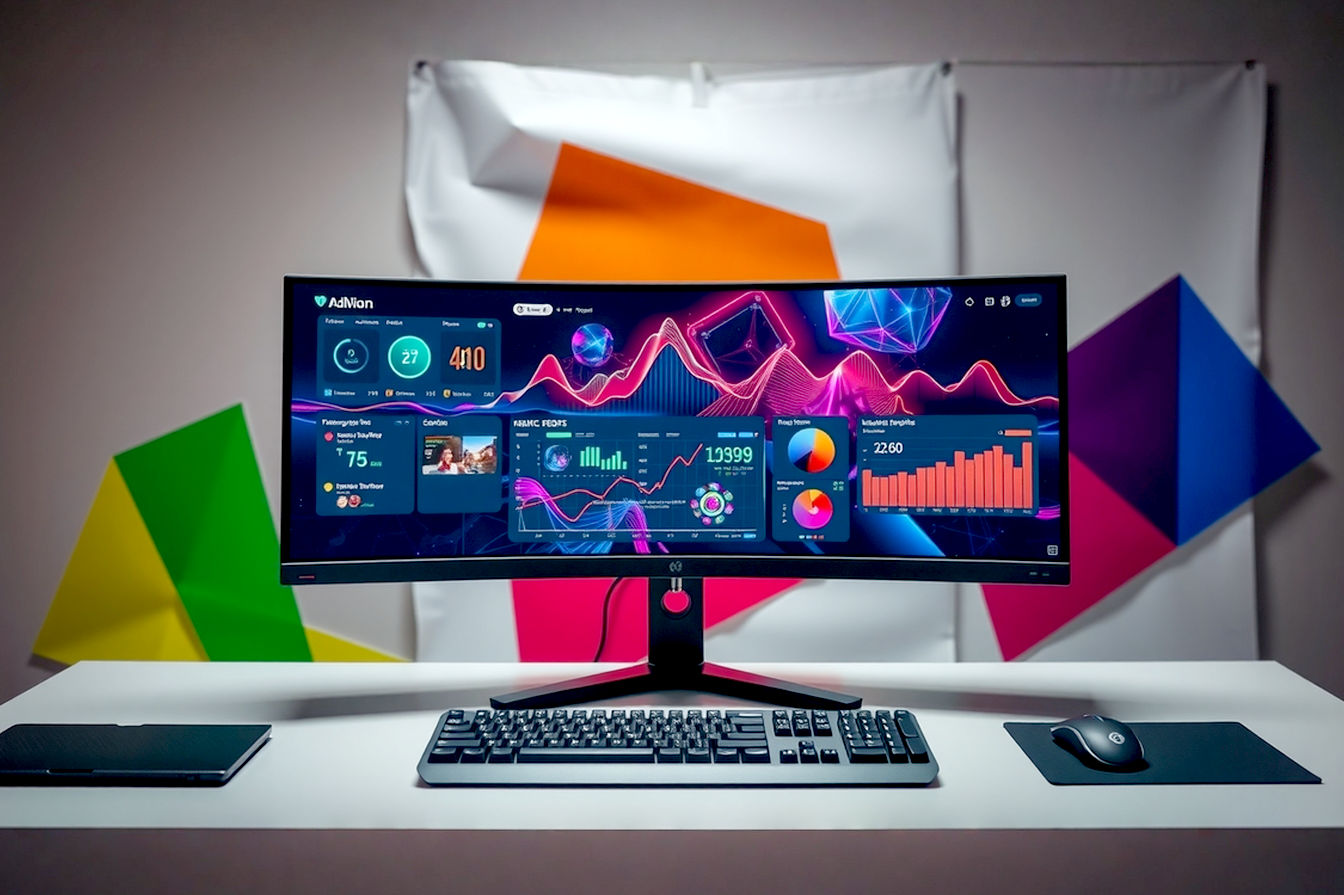This post may contain affiliate links. If you make a purchase through these links, we may earn a commission at no additional cost to you.
Finding ways to boost productivity is something many of us think about constantly. Whether you work from a home office, a bustling corporate space, or somewhere in between, having enough room to manage your tasks efficiently on your computer screen is crucial. For years, the standard setup involved one or maybe two regular monitors. But a newer option has gained serious popularity: the ultrawide monitor. Specifically, the 34-inch ultrawide has caught the eye of professionals looking for an edge.
This isn’t just a bigger screen; it’s a different shape entirely, promising a new way to interact with your computer and your work. It claims to offer a more immersive experience and a massive digital canvas. But is the 34-inch ultrawide monitor truly a game changer for productivity, or is it just a flashy piece of tech? We’re going to dive deep into what these monitors offer, how they stack up against traditional setups, and whether one could genuinely transform how you get things done.
Understanding the 34-Inch Ultrawide Monitor
Before we can figure out if a 34-inch ultrawide monitor can change your work life, it helps to understand exactly what it is. You’ve probably seen standard monitors with a shape that looks wider than it is tall – this is known as a “widescreen” display, typically with a 16:9 aspect ratio. Think of most modern TVs or computer monitors, and you’re thinking of 16:9.
An ultrawide monitor, however, takes that concept much further. Instead of 16 units wide for every 9 units tall, ultrawide displays commonly use a 21:9 aspect ratio. This makes them significantly wider than standard 16:9 screens of the same height. A 34-inch ultrawide monitor, therefore, gives you a screen that measures 34 inches diagonally, but its defining characteristic is that extra width provided by the 21:9 ratio.
To put the aspect ratio in slightly more technical terms, the 16:9 ratio means the width is about 1.78 times the height. The 21:9 ratio (which is technically closer to 64:27 or about 2.37:1) means the width is roughly 2.33 times the height. This difference might sound small, but it results in a much broader horizontal view.
When we talk about a 34-inch ultrawide, the “34-inch” refers to the diagonal measurement from one corner of the screen to the opposite corner. While this number gives you a general sense of size, the aspect ratio is what defines its shape and, crucially, how much horizontal space you get. A 34-inch ultrawide isn’t just a stretched 34-inch 16:9 monitor (which would be enormous); it’s a monitor that’s roughly the height of a 27-inch or 28-inch standard 16:9 monitor but with considerable extra width on both sides. This specific size and shape are key to its proposed productivity benefits.
These monitors typically come with resolutions designed to take advantage of that extra width. The most common resolution for a 34-inch ultrawide is 3440×1440 pixels. This is often referred to as UWQHD (Ultrawide Quad High Definition). We’ll look at why this resolution is important for productivity later, but understanding the 21:9 aspect ratio and the physical size relative to standard monitors is the first step in seeing the potential.
The Core Productivity Advantage: Screen Real Estate
The most immediate and obvious benefit of a 34-inch ultrawide monitor for productivity is the sheer amount of screen real estate it provides. Think of your current monitor setup. How often do you find yourself needing to switch between different windows? Maybe you’re writing a report and need to reference a PDF, or you’re working on a spreadsheet while also needing your email open. On a standard 16:9 monitor, you often have to layer windows on top of each other or constantly use the Alt+Tab shortcut to switch back and forth.
A 34-inch ultrawide monitor with a 3440×1440 resolution dramatically changes this. It offers a vast horizontal canvas that allows you to comfortably place multiple windows side-by-side without significant overlap. Imagine having your main document open in a large section of the screen, your email client visible next to it, and perhaps a web browser or chat application open on the other side. This capability is often referred to as side-by-side multitasking.
To visualize the space, consider a standard Full HD (FHD) monitor with a 1920×1080 resolution. A 3440×1440 ultrawide has nearly twice the horizontal pixel count (3440 vs 1920) and more vertical pixels (1440 vs 1080). This isn’t just a little more space; it’s like having two monitors worth of horizontal space, but without the distracting break in the middle. Compared to a standard 27-inch QHD (Quad High Definition) monitor at 2560×1440, the ultrawide maintains the same vertical pixel count but adds 880 pixels of horizontal space. That’s a significant chunk of extra room.
Certain tasks benefit immensely from this expanded view. For example:
- Spreadsheets: You can see many more columns at once, reducing the need to scroll horizontally. This is incredibly helpful for data analysis or managing large datasets.
- Video Editing: You can have your video timeline stretched across a much wider area, making it easier to navigate and edit precisely. You can also keep preview windows and effects panels open simultaneously.
- Coding: Developers can view more lines of code side-by-side with documentation or a terminal window, improving workflow.
- Graphic Design and CAD: Working on large canvases or complex blueprints becomes more manageable when you can see more of the design without constantly zooming out or panning.
- Project Management: Viewing Gantt charts or task boards across the full width provides a better overview of project timelines and dependencies.
The ability to have all your essential applications visible at a glance significantly reduces the need for constant window management. Instead of searching for the right window or minimizing applications, everything you need is right there in front of you. This seamless workflow can lead to fewer interruptions, better focus, and ultimately, increased efficiency throughout your workday.
Ultrawide vs. Dual Monitors: A Head-to-Head for Productivity
For a long time, the go-to solution for needing more screen space was simply adding a second monitor. The dual monitor setup has been a staple in offices and home workspaces for years, and for good reason. It’s a straightforward way to double your screen real estate, allowing you to dedicate one screen to a primary task and the other to supporting applications like email, chat, or reference material.
The advantages of a dual monitor setup are clear: it’s often more affordable initially, you can mix and match monitor sizes and resolutions (though consistency is usually preferred), and it provides a distinct separation between tasks. However, it also comes with drawbacks. The most noticeable is the bezel – the frame around each screen. With two monitors side-by-side, you have a physical gap in the middle where the bezels meet. This break can be distracting, especially when trying to span a single window or image across both screens.
Setting up dual monitors also typically means more cables (two power cables, two video cables, potentially extra USB cables for hubs) and requires stands that take up desk space, or a dual monitor arm. Managing windows across two distinct displays, while improved by operating system features like snapping, can still feel less fluid than working on a single, continuous surface.
Enter the 34-inch ultrawide as an alternative. Its main pitch is replacing those two monitors with a single, seamless display. This immediately eliminates the bezel issue, providing an uninterrupted workspace. For tasks that benefit from a wide, continuous view, like editing a long video timeline or viewing a very wide spreadsheet, this is a significant advantage.
Let’s look at a direct comparison:
- Bezels vs. Seamless: The ultrawide wins hands down for visual continuity. If you dislike the gap between screens, the ultrawide offers a much cleaner look and feel.
- Desk Space and Cable Management: A single ultrawide monitor generally takes up less desk space than two monitors on their stands, and it requires fewer cables, leading to a cleaner setup.
- Flexibility and Arrangement: Dual monitors offer more flexibility in terms of physical arrangement (side-by-side, one above the other, one in portrait mode). An ultrawide is fixed in its horizontal orientation.
- Consistency: With a single ultrawide, you guarantee perfect consistency in color, brightness, and refresh rate across the entire display. With dual monitors, even identical models can sometimes show slight variations.
- Cost: While the price of a good 34-inch ultrawide can be comparable to buying two decent 24 or 27-inch monitors, high-end ultrawides often come with a steeper price tag than entry-level dual monitor setups. However, when considering the cost of stands or arms for dual monitors, the total cost can sometimes be similar.
So, which setup is better for productivity? It really depends on your workflow.
- If your work involves frequently referencing documents while writing, comparing two documents side-by-side, or tasks that benefit from a very wide, continuous view (like video editing timelines or massive spreadsheets), the ultrawide’s seamless display and expansive horizontal space might be superior.
- If your work benefits from having completely separate “zones” for different tasks, or if you need the flexibility to orient one screen vertically (great for reading long documents or coding), a dual monitor setup might be more effective.
- If budget is the absolute primary concern, two standard monitors might still be the most cost-effective entry point to expanded screen space.
Ultimately, the 34-inch ultrawide offers a compelling alternative to dual monitors, providing a different kind of workspace that many find more immersive and efficient for specific types of tasks. It’s not necessarily a universally “better” option, but for the right user and workflow, it can certainly feel like a significant upgrade.
Key Features That Boost Productivity on Ultrawide Displays
While the large, wide screen is the most obvious feature of a 34-inch ultrawide monitor, several underlying technologies and design elements contribute significantly to its productivity potential. Understanding these features helps you appreciate the full capabilities of these displays beyond just their size.
Resolution (UWQHD 3440×1440)
We touched on this earlier, but the resolution is critical. For a 34-inch ultrawide, the standard resolution is 3440×1440 pixels, known as UWQHD.
Simplified Explanation: Think of resolution as the number of tiny dots (pixels) that make up the image on your screen. More pixels mean a sharper image and, more importantly for productivity, more space to display content. A 3440×1440 screen has a lot more dots than a standard monitor, especially horizontally.
Technical Explanation: A 3440×1440 resolution means the screen displays 3,440 pixels across its width and 1,440 pixels down its height. This results in a total of nearly 5 million pixels (3440 * 1440 = 4,953,600). This is significantly more than a Full HD (1920×1080) monitor, which has just over 2 million pixels, and considerably more horizontal space than a QHD (2560×1440) monitor, which has about 3.7 million pixels.
The pixel density (PPI – Pixels Per Inch) is also important for text clarity. On a 34-inch screen with a 3440×1440 resolution, the pixel density is approximately 109 PPI. This is generally considered a good density for sharpness and readability at a typical viewing distance. For comparison, a 27-inch 1440p monitor has a slightly higher PPI (around 109 PPI), while a 32-inch 4K (3840×2160) monitor has a much higher PPI (around 137 PPI). While a 4K resolution on a smaller screen might offer sharper text, the 3440×1440 on a 34-inch ultrawide provides a good balance between screen size, pixel density for clarity, and the graphics processing power needed to drive it smoothly. The higher pixel count allows you to fit more windows and content on the screen simultaneously without everything appearing too small.
Connectivity
Modern ultrawide monitors often come equipped with a variety of ports that enhance their functionality and simplify your workspace. One of the most valuable is USB-C.
Simplified Explanation: Imagine connecting your laptop to your monitor with just one cable, and that cable does everything – it shows the picture on the screen, lets you plug in your keyboard and mouse to the monitor, and even charges your laptop at the same time! That’s what a good USB-C connection can do.
Technical Explanation: A USB-C port on a monitor that supports DisplayPort Alt Mode and USB Power Delivery (PD) is incredibly versatile. DisplayPort Alt Mode allows the USB-C cable to carry a video signal (like DisplayPort). USB Power Delivery means the monitor can send power back to the connected device, charging your laptop or tablet. Combined with a built-in USB hub in the monitor, a single USB-C cable can connect your laptop to the monitor’s display, provide power, and allow you to use peripherals like a keyboard, mouse, webcam, or external hard drive plugged into the monitor’s USB-A ports. This dramatically reduces cable clutter on your desk. Look for monitors that offer sufficient Power Delivery wattage (e.g., 65W, 90W, or 100W) to adequately charge your specific laptop.
Beyond USB-C, look for standard HDMI and DisplayPort inputs to connect various devices, as well as multiple USB-A ports for peripherals. Some high-end models might also include an Ethernet port (RJ45), allowing your monitor to provide a wired network connection to your laptop over the single USB-C cable, which can be more stable than Wi-Fi.
Picture-by-Picture (PBP) and Picture-in-Picture (PIP)
These features leverage the ultrawide screen’s ability to display content from multiple sources simultaneously.
Simplified Explanation: PBP is like splitting your ultrawide screen into two or more smaller screens, each showing a different computer or device. PIP is like having one main picture on the screen with a smaller window in the corner showing content from another device.
Technical Explanation: Picture-by-Picture (PBP) mode divides the monitor’s display area to show input from two (or sometimes more) different sources side-by-side. For example, you could connect a desktop PC via DisplayPort to one half of the screen and a laptop via HDMI or USB-C to the other half. The monitor essentially acts like two separate displays merged into one physical unit. Picture-in-Picture (PIP) mode displays the full screen from one source as the main image and shows a smaller, resizable window from a second source overlaid on top. These features are particularly useful if you frequently work with multiple computers or need to monitor content from a secondary device while focusing on your primary machine.
KVM Switches
An integrated KVM (Keyboard, Video, Mouse) switch is a feature found on some productivity-focused ultrawide monitors.
Simplified Explanation: A KVM switch lets you control multiple computers using just one keyboard and one mouse connected to the monitor. You can switch between controlling different computers with a simple button press on the monitor.
Technical Explanation: A monitor with a built-in KVM switch has multiple video inputs and USB upstream ports. You connect each computer to a separate video input on the monitor and also connect a USB cable from each computer to a corresponding USB upstream port on the monitor. Your keyboard and mouse are then plugged into the monitor’s shared USB downstream ports. The KVM function allows you to switch which computer receives the input from the shared keyboard and mouse, while the monitor simultaneously switches to the corresponding video input. This is incredibly convenient for users who work with multiple systems (e.g., a work laptop and a personal desktop) and want to avoid cluttering their desk with multiple sets of peripherals.
Ergonomics and Eye Comfort
Spending long hours in front of a screen can lead to eye strain and discomfort. Ultrawide monitors, especially curved ones, often incorporate design features aimed at improving ergonomics.
Simplified Explanation: The screen’s shape and how you can move it can make a big difference in how comfortable you are. Features that reduce glare or change the light color can also help your eyes feel less tired.
Technical Explanation: Many 34-inch ultrawide monitors, particularly those designed for productivity and immersion, feature a curved screen. The idea behind the curve is to make the edges of the large display feel closer to your natural field of vision, reducing the need for your eyes to refocus as you look from the center to the edges of the screen. This can contribute to less eye strain and a more comfortable viewing experience, especially over long periods. Curvature is often measured with an “R” value, like 1800R or 1500R. A lower number indicates a tighter curve (e.g., 1500R is more curved than 1800R). The optimal curvature is subjective and can depend on your viewing distance.
Beyond the curve, look for monitors with a highly adjustable stand that allows you to easily change the height, tilt, and swivel of the screen. Being able to position the monitor correctly at eye level and at an appropriate distance is fundamental to good ergonomics and preventing neck and shoulder strain. VESA mounting compatibility is also important if you plan to use a monitor arm for maximum flexibility in positioning and to free up desk space.
Many monitors also include eye-care technologies. Low Blue Light modes reduce the amount of blue light emitted by the screen, which some studies suggest can disrupt sleep patterns and contribute to eye strain. Flicker-Free technology addresses screen flicker, which is the rapid on-off cycling of the backlight used to control brightness on some monitors. While often imperceptible to the naked eye, this flicker can cause eye fatigue and headaches for some people. Flicker-free technology uses different methods to regulate brightness, eliminating this rapid cycling.
Finding the optimal viewing distance and position for a 34-inch ultrawide is crucial. Due to its width, you generally need to sit slightly further back than you might with a standard monitor to comfortably take in the entire screen without excessive head movement. Positioning the top of the screen roughly at eye level and ensuring the screen is an arm’s length or slightly more away are good starting points, but adjustability is key to finding what works best for you.
These features, from high resolution and versatile connectivity to multi-source display options and ergonomic design, collectively enhance the productivity potential of a 34-inch ultrawide monitor, making it much more than just a larger, wider screen.
Potential Downsides and Considerations
While a 34-inch ultrawide monitor offers compelling advantages for productivity, it’s not without its potential drawbacks. Before deciding if one is right for you, it’s important to consider these factors.
One significant consideration is software compatibility. While most modern applications, especially productivity suites, web browsers, and creative software, work well and scale correctly on ultrawide displays, older or niche programs might not. Some applications might not maximize properly, leaving black bars on the sides, or their user interfaces might not adapt gracefully to the wider aspect ratio, leading to awkwardly stretched or positioned elements. This is less common now than in the early days of ultrawide monitors, but it’s still something to be aware of, especially if you rely on specific legacy software.
Another area where ultrawide monitors aren’t always ideal is consuming gaming and media content that is formatted for the standard 16:9 aspect ratio. When watching movies or playing games designed for 16:9, you will often see black bars on the sides of the screen (sometimes called “pillarboxing”) because the content doesn’t fill the extra width. While many modern games offer native ultrawide support, providing a more immersive experience with an expanded field of view, not all do. Console gaming, in particular, is typically limited to 16:9 output, meaning consoles like PlayStation and Xbox will display with black bars on an ultrawide monitor. If a significant portion of your monitor use is dedicated to 16:9 media, this can be a constant reminder that you’re not using the full screen.
The cost of a 34-inch ultrawide monitor is generally higher than a standard 27-inch 16:9 monitor with similar resolution and features. While prices have become more competitive, especially for entry-level models, high-end ultrawides with advanced features like high refresh rates, better panel technology, or extensive connectivity can represent a significant investment. You need to weigh the productivity benefits against the price tag to determine if it’s a worthwhile expenditure for your specific needs.
Desk space is another practical consideration. While a single ultrawide might take up less space than two monitors, it still requires a considerable amount of horizontal room. You need to ensure your desk is wide enough to comfortably accommodate the monitor and allow for proper ergonomic positioning at the correct viewing distance. If you have a small or shallow desk, a 34-inch ultrawide might feel overwhelming or force you to sit too close.
Driving the higher resolution of a 3440×1440 monitor requires more processing power from your computer’s graphics card compared to a standard 1920×1080 or even 2560×1440 display. While most modern integrated graphics or dedicated entry-level graphics cards can handle displaying the desktop and running productivity applications at this resolution, if you plan on doing more graphically intensive tasks, like video editing, 3D modeling, or gaming (even just occasionally), you’ll need a more capable graphics card to ensure smooth performance.
Finally, there can be an ergonomic adjustment period. Getting used to the width of the screen and learning how to position yourself and the monitor for optimal viewing comfort can take some time. You might find yourself needing to turn your head more initially to see content at the far edges of the screen. While a curved display helps mitigate this, it’s still a wider field of view than most people are accustomed to. Proper setup and perhaps adjusting window layouts are key to making the transition comfortable.
These potential downsides aren’t necessarily dealbreakers, but they are important factors to consider based on your specific use case, budget, and workspace limitations. Understanding them helps you make a more informed decision about whether a 34-inch ultrawide is the right fit for your productivity needs.
Choosing the Right 34-Inch Ultrawide for Productivity
If you’ve weighed the pros and cons and decided that a 34-inch ultrawide monitor could be the productivity boost you’re looking for, the next step is choosing the right one. With various models on the market, focusing on key specifications and features relevant to your work can help narrow down the options.
First, identify your workflow needs. What kind of tasks do you spend most of your time on? Are you primarily working with documents and spreadsheets, doing graphic design or video editing, coding, or managing multiple systems? Your specific needs will influence which features are most important.
Next, look at the key specs. For a 34-inch ultrawide focused on productivity, the resolution is almost certainly going to be 3440×1440 (UWQHD). As discussed, this provides the ideal balance of screen real estate and pixel density for this screen size. While higher resolutions exist in larger ultrawides, 3440×1440 is the standard for 34 inches and offers excellent clarity for work.
The panel type affects color accuracy, contrast, and viewing angles.
- IPS (In-Plane Switching) panels are generally preferred for productivity tasks, especially those involving color-sensitive work like graphic design or photo editing. They offer excellent color accuracy and wide viewing angles, meaning colors and contrast remain consistent even when viewed from the side.
- VA (Vertical Alignment) panels typically offer higher contrast ratios and deeper blacks than IPS panels, which can be great for media consumption. While VA technology has improved, color accuracy and viewing angles can sometimes be less consistent than IPS, though this varies between specific monitors. For general office work, either can be suitable, but for creative professionals, IPS is often the better choice.
The refresh rate determines how many times per second the image on the screen updates. It’s measured in Hertz (Hz). For most productivity tasks, a standard refresh rate of 60Hz or 75Hz is perfectly sufficient. The motion on the screen will appear smooth enough for scrolling, typing, and moving windows. Higher refresh rates (like 120Hz, 144Hz, or even higher) are primarily beneficial for fast-paced gaming, where they provide smoother motion and reduced motion blur. While a higher refresh rate won’t hurt productivity and can make the general desktop experience feel a bit smoother, it’s usually not a necessary feature to prioritize if your main goal is work efficiency, and monitors with higher refresh rates are often more expensive.
Consider your connectivity requirements. If you use a laptop, a monitor with a USB-C port supporting Power Delivery is a major convenience, allowing a single cable connection for display, data, and charging. Think about how many USB-A ports you need for peripherals. If you work with multiple computers, an integrated KVM switch could be a workflow game-changer. Ensure the monitor has the necessary video inputs (DisplayPort, HDMI) for all the devices you plan to connect.
Ergonomic features are vital for long-term comfort. Look for a monitor with a stand that offers generous height, tilt, and swivel adjustments. If the included stand is limited or you want more flexibility and desk space, ensure the monitor is VESA mount compatible so you can attach it to a monitor arm. Decide if you prefer a flat or curved screen; for a 34-inch size, many users find a moderate curve (like 1800R or 1500R) more immersive and comfortable for reducing eye strain by keeping the edges within your peripheral vision. Don’t forget to check for eye-care technologies like low blue light and flicker-free certification.
Finally, set a budget. Ultrawide monitors range in price based on their features, panel quality, and brand. Determine how much you’re willing to spend and look for models that offer the best combination of the features you need within that price range. Sometimes, sacrificing a high refresh rate or a very tight curve can lead to significant cost savings without impacting core productivity benefits.
By carefully considering these factors – your workflow, resolution, panel type, connectivity, ergonomic features, and budget – you can choose a 34-inch ultrawide monitor that is well-suited to your specific productivity needs and provides the best value for your investment.
Conclusion: Is the 34-Inch Ultrawide a Game Changer?
After exploring the features, benefits, and potential drawbacks of the 34-inch ultrawide monitor, it’s time to answer the central question: Is it a game changer for productivity?
Based on its capabilities, the answer is nuanced, but for many professionals, it absolutely can be a significant upgrade and, depending on their specific workflow, genuinely transformative.
The primary advantage lies in the expansive screen real estate provided by the 21:9 aspect ratio and 3440×1440 resolution. The ability to comfortably display multiple windows side-by-side without bezels allows for seamless multitasking, reduces the need for constant window switching, and provides a much broader view for applications like spreadsheets, timelines, and creative software. This can lead to a more focused, efficient, and fluid workflow for tasks that benefit from a wide, continuous canvas.
Compared to a traditional dual monitor setup, the ultrawide offers a cleaner, more aesthetically pleasing workspace with fewer cables and no distracting bezel gap. Features like integrated USB-C connectivity with Power Delivery, PBP/PIP modes, and KVM switches further enhance its utility, simplifying connections and allowing for easier management of multiple devices. Ergonomic considerations, including curved panels and adjustable stands, contribute to a more comfortable long-term computing experience, potentially reducing eye strain and physical discomfort.
However, it’s not a universal solution. Potential downsides like software compatibility issues with older programs, black bars on 16:9 content, a higher cost compared to basic setups, the need for ample desk space, and the requirement for a capable graphics card are all factors that might make it less suitable for some users. The adjustment period to the wider field of view is also something to consider.
Ultimately, the 34-inch ultrawide monitor is most likely a game changer for individuals whose productivity heavily relies on:
- Extensive multitasking with multiple applications open simultaneously.
- Working with wide-format content like large spreadsheets, video timelines, or complex design layouts.
- Seeking a cleaner, more streamlined workspace than a dual monitor setup offers.
- Benefiting from advanced connectivity features like single-cable USB-C or integrated KVM.
For users with simpler workflows, limited desk space, or those who primarily consume 16:9 media, the benefits might be less pronounced, and a standard monitor or dual monitor setup could be a better fit.
In conclusion, the 34-inch ultrawide monitor, particularly with a 3440×1440 resolution, is a powerful tool that offers a distinct and often superior way to work for many. It provides a level of immersion and multitasking efficiency that standard monitors simply can’t match. While it requires careful consideration of your needs and potential drawbacks, for the right person, it is indeed more than just a bigger screen – it’s a workspace evolution that can genuinely be a game changer for productivity. As display technology continues to advance, ultrawide monitors are likely to become even more prevalent, further solidifying their place as a top choice for professionals seeking to maximize their efficiency.

